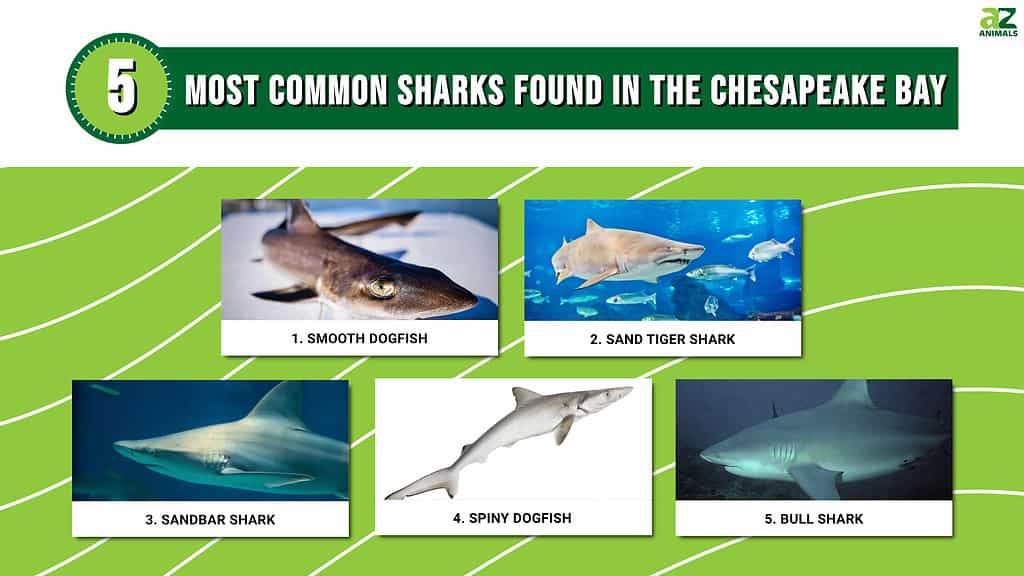
The Chesapeake Bay is located on the East Coast of the United States, more commonly known as the Eastern Shore. The Chesapeake is known worldwide as the official home of the Maryland blue crab! However, humans are not the only ones who love the culinary wonders of the Chesapeake. The blue crab also gets the attention of sharks! There are twelve known species of shark that can be found in the Chesapeake Bay, although some of these are rarely sighted. Of that twelve, there are five common sharks found in the Chesapeake Bay, including a shark species with a bit of a bad reputation!
The Five Most Common Sharks Found In The Chesapeake
While there are twelve known species of shark that have been sighted in the Chesapeake Bay, only five are considered a common occurrence. Most of these sharks are considered harmless, but two species are dangerous to humans when encountered. Additionally, two of the shark species in the Chesapeake are vulnerable or near threatened. Therefore, it is important to know how to tell each species apart should you encounter them!
The Smooth Dogfish
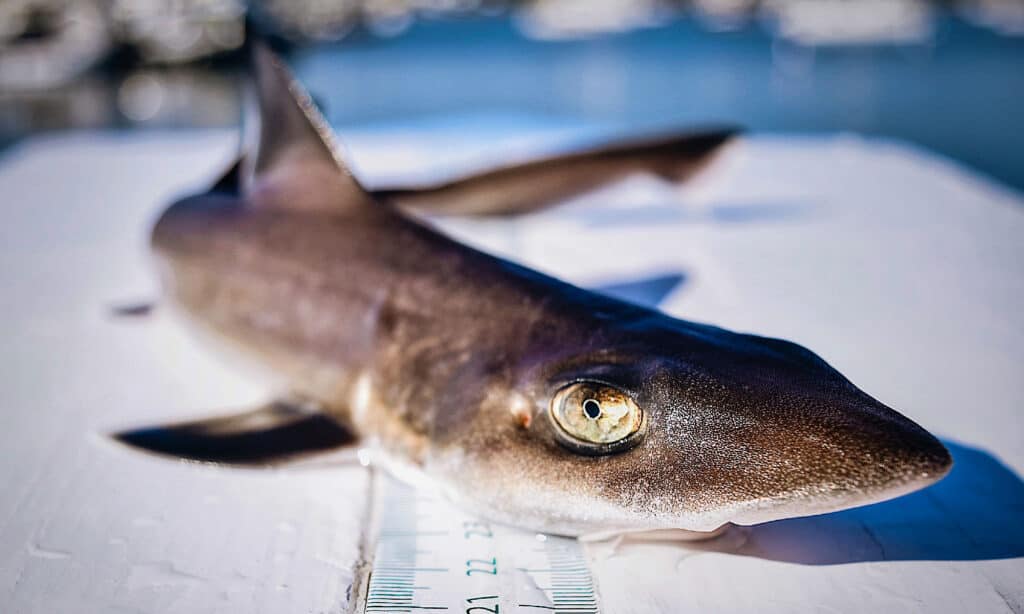
Smooth dogfish is one of the most common species found in the Bay.
©Rafeed Hussain/Shutterstock.com
The smooth dogfish poses no danger to humans whatsoever and is one of the most common species of sharks found in the Chesapeake Bay. It has gained popularity in the commercial fishing industry of the Mid-Atlantic coasts. Unlike many other shark species, the smooth dogfish has flat teeth due to their preferred prey of crustaceans and bivalve invertebrates.
Smooth dogfish is one the smallest shark species, between 38 and 48 inches long and around 8 pounds on average. This shark is greyish brown in color with a yellow-tinged white or light grey underbelly. It also darkens or lightens in color to blend into its surroundings.
This shark species can be identified by its catlike eyes, triangular fins, two dorsal fins, and notched asymmetrical tail. Unlike the spiny dogfish, the smooth dogfish lacks dorsal spines.
The Sand Tiger Shark
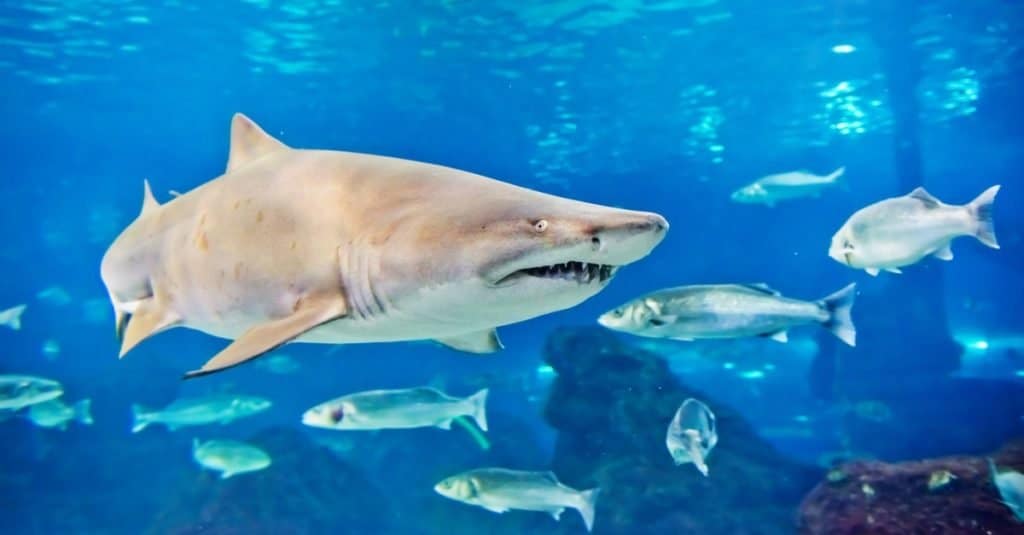
Sand
tiger
sharks are the most common sharks in public aquariums.
©Valeri Potapova/Shutterstock.com
There are four species grouped under the common name sand tiger shark, and despite their scary teeth, none of them are aggressive to humans. They are the most common species of sharks at most aquariums! Sand tigers are between 110 and 661 pounds and between 6.6 to 10.5 feet long. While specific colors vary by species, Sand tigers have grey to brown, rough scales that fade to a paler underbelly and copper or brown spots over the body and fins.
Sand tiger sharks of all species are easily identified by their two spineless dorsal and anal fins, overall equal in size. These sharks also have two pectoral fins located behind their last row of gills. Species of Sand tiger sharks travel in schools or shoals and tend to avoid humans whenever possible. Due to overfishing, populations of sand tigers in the Chesapeake have dropped 20% in recent years. As a result, the sand tiger shark is classified as vulnerable by all states surrounding the bay.
The Sandbar Shark

Sandbar shark prefers deeper waters.
©Vladimir Wrangel/Shutterstock.com
The sandbar shark, also called the brown shark, is between 6 and 7.5 feet long and up to 400 hundred pounds on average. Sandbars are more commonly spotted closer to Florida coastlines but are occasionally found in the Chesapeake. While these sharks pose some risk for bite injuries, most humans do not encounter them while swimming. The Sandbar tends to stick to depths over two hundred feet.
Sandbar sharks are light tan to brown in color with a white underbelly. This species has a short, broad, round snout and a lean body. Sandbars are most easily identified by their pronounced intraoral ridge and their large, high first dorsal fin starting over the pectoral fin. They prefer deeper waters during the summer months and are bottom feeders.
The Spiny Dogfish
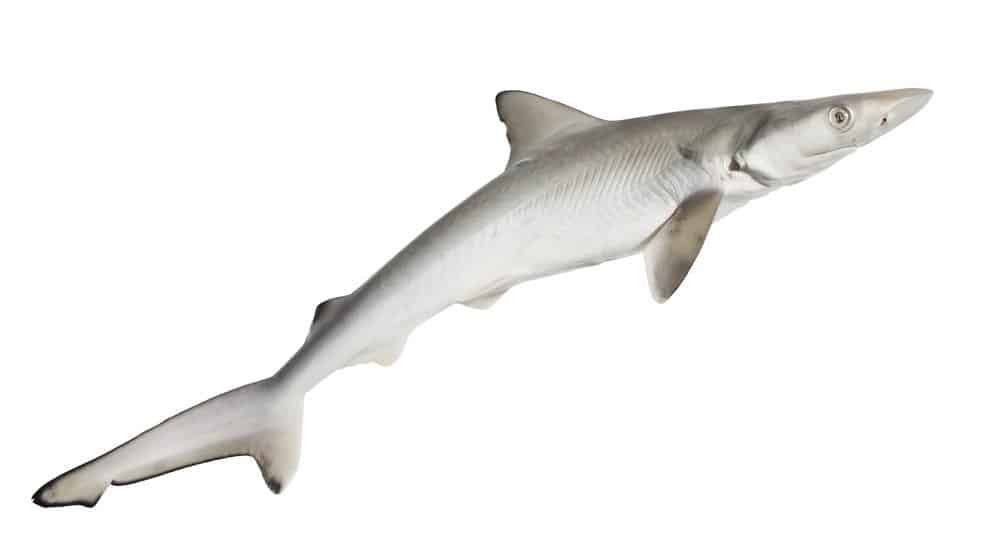
The spiny dogfish is a potential danger due to its venomous dorsal spines.
©IrinaK/Shutterstock.com
There are two species grouped under this common name, but the one found in the Bay is the Atlantic spiny dogfish. The spiny dogfish is tied with the smooth dogfish as the smallest shark commonly found in the Chesapeake. However, despite its size, it poses a potential danger to humans.
Spiny dogfish is the same average weight and length as smooth dogfish but can be easily distinguished. It is mottled brown and grey that fades from the back of the body down. This fading transitions to a white underbelly.
This species can be easily identified by the white spotting along their sides and the set of protruding spines near the dorsal fin. These spines are filled with painful venom and are used in defense to ward off capture by prey. While the venom in their spines is not lethal to humans, it is extremely painful.
Additionally, due to overfishing, the spiny dogfish is classified as Critically Endangered in the Atlantic Ocean.
The Bull Shark
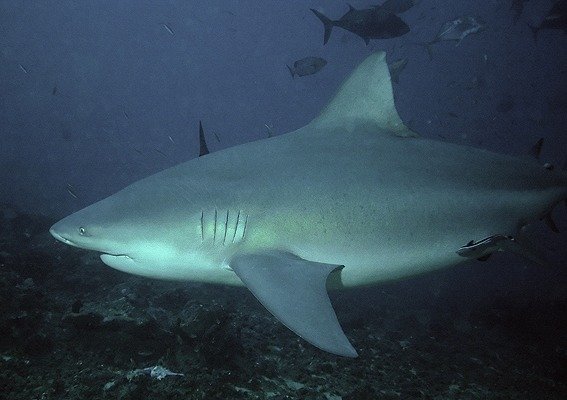
Bull Sharks are the third most dangerous shark species in the world.
©Pterantula, CC BY-SA 3.0, via Wikimedia Commons – License
The bull shark is the most dangerous shark found in the Chesapeake and the third most dangerous shark species in the world. Bull sharks weigh between 200-500lbs on average and are between 7 and 11.5 feet long. This species has a thick, powerful greyish-blue body and a white underbelly with little to no markings. Bull sharks can be visually identified by their flat, round snouts and two dorsal fins without an intradorsal ridge.
The Bull shark can swim up to 25mph and has the strongest bite pressure of any shark for its size. Visitors to the Chesapeake rarely encounter the bull shark, as it migrates to deeper waters during the summer tourist months.
Sharks Found In The Chesapeake: Are They Dangerous?
While the bull shark has a frightening reputation for being aggressive, there has never been a shark attack reported in the Chesapeake Bay. The risk of being attacked by a shark is surprisingly low. Statistically speaking, you are at greater risk of being struck by lightning than attacked by a shark.
However, minimal risk differs from no risk, and individuals should be mindful. Remember, you are entering the shark’s habitat when swimming in the Bay. Like any other animal, sharks can be negatively impacted by our presence if we are not careful. The presence of sharks in the Chesapeake Bay is vital! They signify a strong and thriving ecosystem that the Eastern Shore has worked tirelessly to preserve. The sharks found in the Bay are a welcome sign that those efforts have paid off!

The presence of sharks in the Chesapeake Bay signifies a thriving ecosystem.
©iStock.com/vchal
Shark Spotting 101: How To Avoid Meeting A Shark, And What To Do If You See One
While the chance of being attacked in the Chesapeake by a shark is slim, you should still take precautions. The Chesapeake is one of the most vital nursery habitats for sandbar sharks, a vital part of the ecosystem. Their presence, as well as other marine animals native to the Bay, is essential for keeping the Chesapeake healthy and beautiful!
To avoid your risk of encountering a shark while swimming:
- Do not swim at dawn, dusk, or night
- Wear reflective or shiny swim gear
- Do not swim where others are fishing
- Do not swim near drop-offs
- Never swim alone
If you spot a shark in the Chesapeake Bay, move a safe distance away and out of the water. Then, report the sighting to the Maryland Department Of Natural Resources or the Virginia Department of Natural Resources.
Summary of The Five Most Common Sharks Found In The Chesapeake Bay
Explore all the details about these five most common sharks you can find in the Chesapeake Bay.
| Number | Shark | Weight | Length | Harmless or Dangerous? |
|---|---|---|---|---|
| 1 | Smooth Dogfish | 8 lbs | 38 in – 48 in | Harmless |
| 2 | Sand Tiger Shark | 110-661 lbs | 6.6 feet – 10.5 feet | Harmless |
| 3 | Sandbar Shark | 400 lbs | 6 feet – 7.5 feet | Dangerous |
| 4 | Spiny Dogfish | 8 lbs | 38 in – 48 in | Harmless |
| 5 | Bull Shark | 200-500lbs | 7 feet – 11.5 feet | Dangerous |
The photo featured at the top of this post is © Havoc/Shutterstock.com
Thank you for reading! Have some feedback for us? Contact the AZ Animals editorial team.






